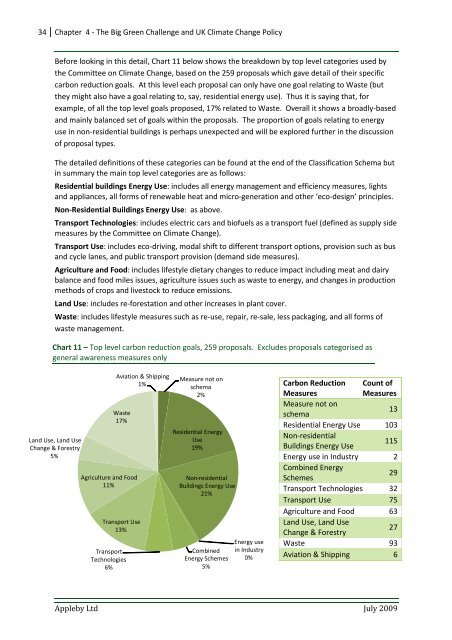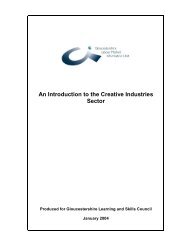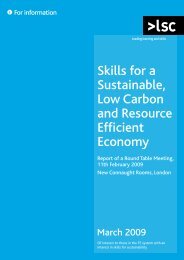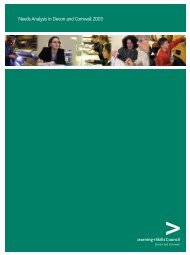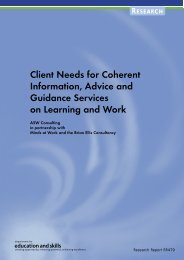Mapping the Big Green Challenge - The Skills & Learning ...
Mapping the Big Green Challenge - The Skills & Learning ...
Mapping the Big Green Challenge - The Skills & Learning ...
You also want an ePaper? Increase the reach of your titles
YUMPU automatically turns print PDFs into web optimized ePapers that Google loves.
34 Chapter 4 - <strong>The</strong> <strong>Big</strong> <strong>Green</strong> <strong>Challenge</strong> and UK Climate Change PolicyBefore looking in this detail, Chart 11 below shows <strong>the</strong> breakdown by top level categories used by<strong>the</strong> Committee on Climate Change, based on <strong>the</strong> 259 proposals which gave detail of <strong>the</strong>ir specificcarbon reduction goals. At this level each proposal can only have one goal relating to Waste (but<strong>the</strong>y might also have a goal relating to, say, residential energy use). Thus it is saying that, forexample, of all <strong>the</strong> top level goals proposed, 17% related to Waste. Overall it shows a broadly-basedand mainly balanced set of goals within <strong>the</strong> proposals. <strong>The</strong> proportion of goals relating to energyuse in non-residential buildings is perhaps unexpected and will be explored fur<strong>the</strong>r in <strong>the</strong> discussionof proposal types.<strong>The</strong> detailed definitions of <strong>the</strong>se categories can be found at <strong>the</strong> end of <strong>the</strong> Classification Schema butin summary <strong>the</strong> main top level categories are as follows:Residential buildings Energy Use: includes all energy management and efficiency measures, lightsand appliances, all forms of renewable heat and micro-generation and o<strong>the</strong>r ‘eco-design’ principles.Non-Residential Buildings Energy Use: as above.Transport Technologies: includes electric cars and biofuels as a transport fuel (defined as supply sidemeasures by <strong>the</strong> Committee on Climate Change).Transport Use: includes eco-driving, modal shift to different transport options, provision such as busand cycle lanes, and public transport provision (demand side measures).Agriculture and Food: includes lifestyle dietary changes to reduce impact including meat and dairybalance and food miles issues, agriculture issues such as waste to energy, and changes in productionmethods of crops and livestock to reduce emissions.Land Use: includes re-forestation and o<strong>the</strong>r increases in plant cover.Waste: includes lifestyle measures such as re-use, repair, re-sale, less packaging, and all forms ofwaste management.Chart 11 – Top level carbon reduction goals, 259 proposals. Excludes proposals categorised asgeneral awareness measures onlyLand Use, Land UseChange & Forestry5%Agriculture and Food11%TransportTechnologies6%Aviation & Shipping1%Waste17%Transport Use13%Measure not onschema2%Residential EnergyUse19%Non-residentialBuildings Energy Use21%CombinedEnergy Schemes5%Energy usein Industry0%Carbon ReductionMeasuresCount ofMeasuresMeasure not onschema13Residential Energy Use 103Non-residentialBuildings Energy Use115Energy use in Industry 2Combined EnergySchemes29Transport Technologies 32Transport Use 75Agriculture and Food 63Land Use, Land UseChange & Forestry27Waste 93Aviation & Shipping 6Appleby Ltd July 2009


